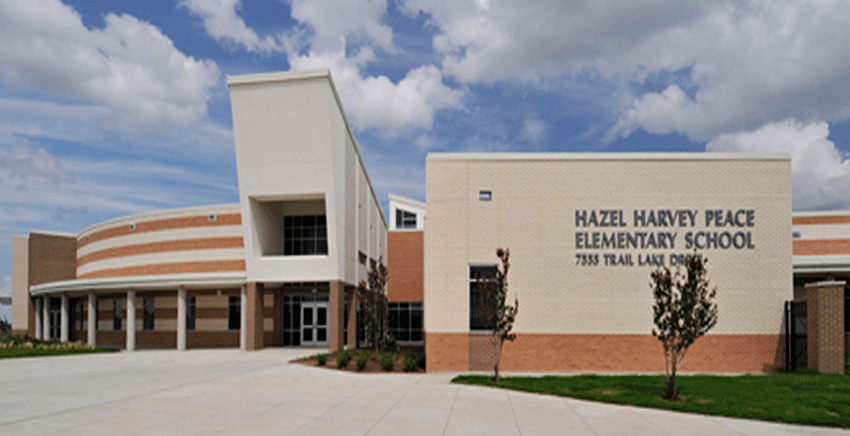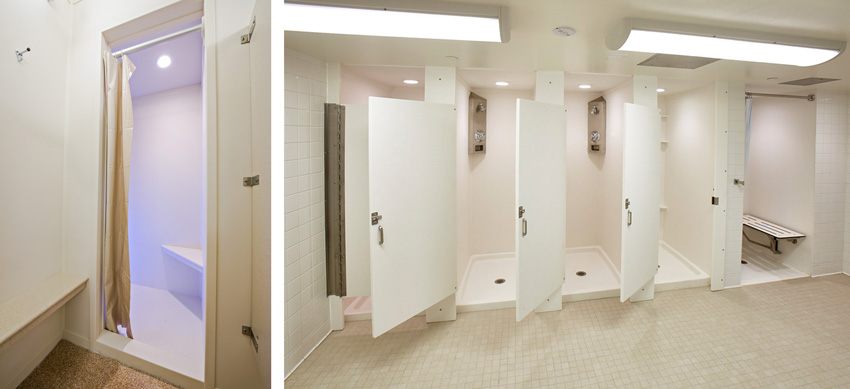Improving School Environments by Design
SBS Roofing Systems
Another popular choice for low-slope roofing membranes on school projects is styrene butadiene styrene (SBS) modified bitumen roofing. The modification provided by SBS copolymer gives the asphalt bitumen membrane a rubber-like characteristic by forming a polymer network inside the bitumen material. The SBS allows for increased flexibility and durability, while the asphalt provides proven waterproofing capabilities. This combination makes SBS a premier solution in terms of providing long-term protection to the building.

Photo courtesy of SOPREMA, Inc.
SBS modified roofing is used very successfully and economically on school buildings including the Hazel Harvey Peace Elementary School in Fort Worth, Texas, shown here.
SBS membranes can be applied in many ways, but two methods of particular importance for schools are mechanically fastened and the use of self-adhering products. Mechanically fastened SBS provides the highest wind uplift in its class, which is especially important in places like Florida and coastal areas that experience high-wind events. Combining a mechanically fastened SBS base sheet in a two-ply SBS system achieves superior performance with the longevity of SBS. Self-adhered SBS has been developed to create extremely strong interply adhesion with no open flames, hot kettles, or VOCs and odors.
Adhesives are also available for field installation between layers of membranes or applied directly to concrete roof decks. While applied directly to a concrete roof deck, the resulting “ribbon pattern” creates natural venting for the concrete and provides extremely high bond strength. This helps the moisture in the concrete leave the roof system over time without affecting the integrity of the assembly or its components. As a high-performance, single-component polymeric adhesive, when used as an interply adhesive, it provides an additional layer of elastomeric waterproofing protection beneath or between plies of membranes once the adhesive is cured. Also, these adhesives are solvent free and extremely low in VOCs, providing superior performance while ensuring a safe installation for the contractor, occupants, and environment.
Coating/Liquid-Applied Membranes
There are plenty of situations where special roofing conditions arise that are not easily addressed by membrane solutions. These can include atypical conditions along roofing edges or intersections with other surfaces, areas of premature aging, or areas needing special waterproofing attention, such as flashings. In these cases, the use of liquid-applied coatings or membranes is ideal since they can conform to any shape and cover the needed area seamlessly when cured. These types of products are also well suited for roofs that require a roof “extension” by covering overworn or problem areas until a complete, new roof can be installed. In some cases, liquid-applied membranes can even serve as a completely new system for a total roof area. Depending on the chemistry of the products being used, low-odor options are available that cause very little, if any disturbance to the building below, such that occupants may not even know roofing work is going on above. The use of these specialized products requires careful consultation with the manufacturer for suitability on surfaces and conditions required for application. In many cases, a primer may be needed to be sure the coating adheres properly to the substrate. Installed correctly, these types of systems provide considerable, reliable, and long-lasting protection to selected new or existing roof areas.
Restrooms and Locker Rooms
Recent cultural shifts have moved architects and designers to think less about large school restrooms with ganged fixtures and more about providing greater privacy and gender-neutral options. There is also a need to be sure that accessible design is being incorporated into school facilities in appropriate and sometimes innovative ways. Such creative solutions can defuse otherwise contentious situations and in some cases conserve square footage in buildings. This can be manifest in several ways, discussed as follows.
Shower Stall Privacy
School gymnasiums with locker rooms and showers have been common programmatic elements of educational facilities. For decades, the norm has been to provide communal showers in situations like this. The concept made sense since multiple showering “stations” within a given space increased efficiency and capacity while reducing mechanical first costs in new construction. But, as we have noted, times and culture have changed. There are new norms about bathing privacy that have raised concerns and challenges related to bathroom and shower design. Further, additional risks of serious bacterial infections for athletes and other users puts new focus on the design and surface cleanliness of communal shower installations.
One answer for increased privacy in showering is to use separated shower stalls or compartments. To be effective, they need to include spaces not just for showering but also adequate dry-floor changing space that allows bathers to disrobe and get dressed within that space. In designs where space may not allow the combined shower and changing area, then a more inline approach with individual showering spaces can be used.
Disease Control
Selecting a material for the shower stalls can be important in the health of students. Methicillin-Resistant Staphylococcus Aureus (MRSA, pronounced “mer-sah”) is a bacteria of concern here. MRSA is classed by the Centers for Disease Control (CDC) and the medical profession as one of the deadly “superbugs,” with infections considered extremely serious. There have been outbreaks of this bacteria in a variety of sports locker rooms, which has prompted a number of recommendations for cleaning and disinfecting them regularly. The recommendations also include avoiding tile and grout that can be damaged and harbor bacteria. Instead, the use of solid-surface material can be an effective way to avoid any potential MRSA buildups and facilitate cleaning. Hence, in the interest of healthier showers, many designers are choosing solid-surface material for the shower enclosure, eliminating the need for grout lines.

Photo courtesy of Inpro
Private shower stalls with private changing areas, all made out of solid-surface materials, offer safer, cleaner alternatives, reflecting the changing design needs in schools.
Solid-surface shower enclosures have become popular because they offer aesthetic design options in addition to their practical performance aspects. They are available in a range of colors and patterns to blend with a variety of interior design concepts. By selecting large-sized sheets, there are fewer seams, which means less cutting, waste, and cost in addition to the hygienic benefit. The material is typically nonporous too, which means it does not support the growth of mold, mildew, or bacteria.
Notice

www.inprocorp.com


www.soprema.us









